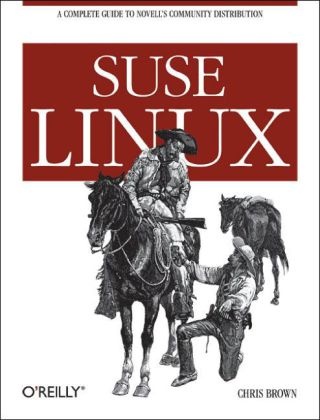Share
Fr. 55.50
Chris Brown, Chris Brown, Phd Chris Brown
SUSE Linux - A Complete Guide to Novell's Community Distribution
English · Paperback / Softback
Shipping usually within 3 to 5 weeks
Description
SUSE Linux: A Complete Guide to Novell's Community Distribution will get you up to speed quickly and easily on SUSE, one of the most friendly and usable Linux distributions around. From quick and easy installation to excellent hardware detection and support, it's no wonder SUSE is one of the most highly rated distributions on the planet. According to Novell, SUSE is installed more than 7,000 times every day, an average of one installation every 12 seconds.This book will take you deep into the essential operating system components by presenting them in easy-to-learn modules. From basic installation and configuration through advanced topics such as administration, security, and virtualization, this book captures the important details of how SUSE works--without the fluff that bogs down other books and web sites. Instead, readers get a concise task-based approach to using SUSE as both a desktop and server operating system.In this book, you'll learn how to: Install SUSE and perform basic administrative tasks Share files with other computers Connect to your desktop remotely Set up a web server Set up networking, including Wi-Fi and Bluetooth Tighten security on your SUSE system Monitor for intrusions Manage software and upgrades smoothly Run multiple instances of SUSE on a single machine with XenWhether you use SUSE Linux from Novell, or the free openSUSE distribution, this book has something for every level of user. The modular, lab-based approach not only shows you how--but also explains why--and gives you the answers you need to get up and running withSUSE Linux.About the author:Chris Brown is a freelance author and trainer in the United Kingdom and Europe. Following Novell's acquisition of SUSE, he taught Linux to Novell's consultants and IT staff and is certified in both Novell's CLP program and Red Hat's RHCE. Chris has a PhD in particle physics from Cambridge.
List of contents
Preface
1. Quick Start
1.1 Installing SUSE Linux from Local Media
1.2 Set Up a Local Printer
1.3 Get Started with Email
1.4 Configure a Network Card
1.5 Access Documentation
2. Basic System Administration
2.1 View and Edit Text Files
2.2 Explore the Filesystem
2.3 Manage Files and Directories
2.4 Set File Access Permissions and Ownership
2.5 Access a Remote Printer
2.6 Create User Accounts
2.7 Rescue a System That Won't Boot
2.8 Finding Files
2.9 Mounting Filesystems
2.10 Access Your Desktop Remotely
3. Using SUSE Linux on Your Desktop
3.1 Configure Your Graphics Card and Monitor
3.2 Configure Your Keyboard and Mouse
3.3 Configure the KDE Menus and Panel
3.4 Configure the KDE Desktop
3.5 Lock Down the Desktop for Kiosk Mode
3.6 Configure the GNOME Desktop
3.7 Play Audio and Video
3.8 Burn Your Own CDs and DVDs
3.9 Capture Screenshots
3.10 Use Command-Line Tools
3.11 Configure Multiheaded Displays
3.12 Animate the Desktop with Xgl and Compiz
4. Using Linux on Your Laptop
4.1 Configure Laptop Power Management
4.2 Configure Wireless Networking
4.3 Configure Bluetooth Devices
4.4 Synchronize Files with Your Desktop
5. Package Management
5.1 Find Out What's Installed
5.2 Finding the Packages You Need
5.3 Install and Upgrade RPMs
5.4 Remove Software Packages
5.5 Perform an Online Update
5.6 Manage Software Packages Using ZENWorks
5.7 Manage Software Packages Using YUM
5.8 Compile and Install Source Code
6. System Administration for Servers
6.1 Control Boot-Time Service Startup
6.2 Start Services on Demand
6.3 Create and Mount Disk Partitions
6.4 Create Logical Volumes
6.5 Monitor and Manage Processes
6.6 Examine and Manage Log Files
6.7 Monitor System Load and Performance
6.8 Backup and Restore Filesystems
6.9 Configure and Debug Network Interfaces
6.10 Configure Name Resolution
7. Network Services
7.1 Set Up Disk Quotas
7.2 Configure a DNS Server
7.3 Share Files Using NFS
7.4 Serve Filesystems to Windows with Samba
7.5 Configure a DHCP Server
7.6 Configure a Web Server with Apache
7.7 Configure a Mail Server
8. Security
8.1 Set a Boot-Time Password
8.2 Provide Secure Remote Login with SSH
8.3 Set Up a Firewall
8.4 Define a Security Level
8.5 Provide Role-Based Access Control with sudo
8.6 Assess Vulnerabilities Using Nessus
8.7 Detect Intrusion
8.8 Protect Your Applications with AppArmor
9. Alternative Installations
9.1 Configure a Dual-Boot System
9.2 Install from an Installation Server
9.3 Automate Installations with AutoYaST
9.4 Run Multiple Operating Systems with Xen
Index
About the author
Summary
Presents operating system components, from basic installation and configuration through topics such as administration, security, and virtualization. This book captures the details of how SUSE works. It helps how to: install SUSE and perform basic administrative tasks; set up a web server; monitor for intrusions; and more.
Product details
| Authors | Chris Brown, Chris Brown, Phd Chris Brown |
| Publisher | O'Reilly Media |
| Languages | English |
| Product format | Paperback / Softback |
| Released | 01.01.2006 |
| EAN | 9780596101831 |
| ISBN | 978-0-596-10183-1 |
| No. of pages | 446 |
| Weight | 712 g |
| Illustrations | w. figs. |
| Series |
O'Reilly Ser. |
| Subjects |
Natural sciences, medicine, IT, technology
> IT, data processing
> Operating systems, user interfaces
COMPUTERS / Operating Systems / General, COMPUTERS / Programming / Open Source, Open source and other operating systems, Linux, YaST, open source, rpm, SUSE |
Customer reviews
No reviews have been written for this item yet. Write the first review and be helpful to other users when they decide on a purchase.
Write a review
Thumbs up or thumbs down? Write your own review.

